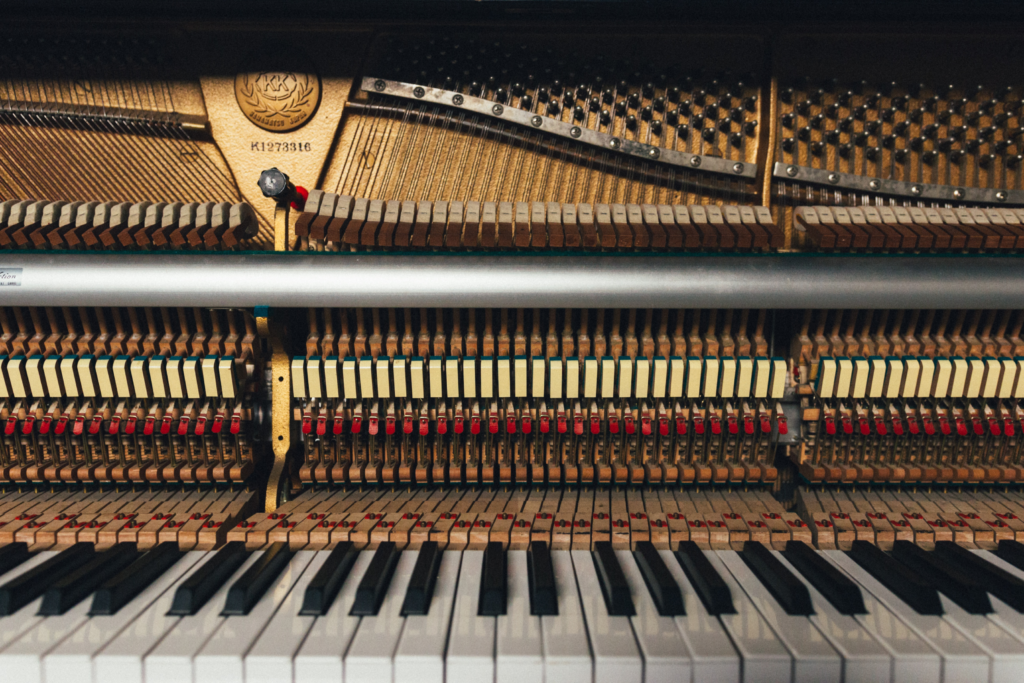Ah, the piano! The majestic instrument that has given birth to some of the most iconic pieces in the realm of music. From classical music masterpieces to the catchy tunes of pop songs, the piano has been the backbone of countless memorable melodies.
But if you’re just starting out, the vast world of piano music can seem a tad overwhelming. And if you barely know how to read sheet music, where do you even begin?
Fear not, budding pianist! We’ve got a list of great songs for beginners that’ll have you sounding impressive in no time. So, let’s dive in and start playing some of the easiest piano songs!

Moonlight Sonata by Ludwig van Beethoven
“Moonlight Sonata” by Ludwig van Beethoven is an excellent piece for beginners learning to play the piano. Its hauntingly beautiful melody notes provide an introduction to the essence of classical music, allowing novice pianists to familiarize themselves with the nuances of emotive playing.
How to Play “Moonlight Sonata” by Beethoven on the Piano for Beginners
“Moonlight Sonata” by Ludwig van Beethoven is a masterpiece in the realm of solo piano music. Its hauntingly beautiful melodies and intricate broken chords have captivated audiences for centuries. While the complete sonata can be complex, we’ll focus on a simplified version of the first movement, making it accessible for piano beginners. Let’s break down how to play this classical gem on the piano, step by step.
Getting Familiar with the Keys

Before we delve into the sonata, it’s essential to familiarize yourself with the piano keys. The white keys on the piano are named after the first seven letters of the alphabet: A, B, C, D, E, F, and G. The key to the immediate left of a group of two black keys is C. Find middle C on your keyboard; it’s typically located near the center of the keyboard.
Notes Used in “Moonlight Sonata” by Beethoven

For this beginner’s version of the first movement, we’ll be using the following notes, which include both white and black keys:
- C
- D
- E
- F
- G
- A
- B
- C# (the black key immediately after C)
Playing the Song
Here’s a breakdown of a simplified version of the first movement of “Moonlight Sonata” with the corresponding notes:
- Main Theme: C# E G | C# E G A | B G E C# | B G E C#
(Note: This version focuses on playing triads and broken chords to capture the essence of the piece.)
Step-by-Step Instructions
- Position Your Right Hand:
- Place your thumb (1st finger) on C#, your middle finger (3rd finger) on E, and your little finger (5th finger) on G.
- Start with the Main Theme:
- Play the broken chords starting with C# using your thumb, then E with your middle finger, and G with your little finger.
- Continue the pattern, but this time, after playing G, move to A with your thumb of the left hand.
- Transition to B using your ring finger of the left hand, then G with your little finger, E with your middle finger, and finish with C# using your thumb.
- Repeat the last sequence, emphasizing the solo piano nature of the piece by playing one note at a time with a gentle touch.
Happy Birthday to You

Another universal folk song! The “Happy Birthday” tune is not only a must-know for every piano player but also a great song to practice your right hand melody. With just a few notes and basic major chords, you’ll be playing this simple song at every birthday party in no time.
How to Play “Happy Birthday to You” on the Piano for Beginners
“Happy Birthday to You” is arguably one of the most recognized songs worldwide. Whether it’s a family gathering or a surprise party for a friend, knowing how to play this song on the piano can be a delightful skill to have. Let’s break down how to play this celebratory tune on the piano, step by step.
Getting Familiar with the Keys
Before we jump into the song, it’s essential to familiarize yourself with the piano keys. The white keys on the piano are named after the first seven letters of the alphabet: A, B, C, D, E, F, and G. The key to the immediate left of a group of two black keys is C. Find middle C on your keyboard; it’s typically located near the center of the keyboard.
Notes Used in “Happy Birthday to You”
For this tutorial, we’ll be using the following notes, which include both white and black keys:
- C
- D
- E
- F
- G
- A
- High C (the C an octave above middle C)
- B flat (the black key immediately before B)
Playing the Song
Here’s a breakdown of “Happy Birthday to You” with the corresponding notes:
- Happy Birthday to you: C C D C F E
- Happy Birthday to you: C C D C G F
- Happy Birthday dear [Name]: C C High C E F D B flat A
- Happy Birthday to you: F F E C G F
Step-by-Step Instructions
- Position Your Right Hand: Place your thumb (1st finger) on C, your index finger (2nd finger) on D, your middle finger (3rd finger) on E, your ring finger (4th finger) on F, and your little finger (5th finger) on G.
- Start with the First Line:
- Play C twice with your thumb.
- Move to D and play it once with your index finger.
- Return to C and play it once with your thumb.
- Play F with your ring finger and then E with your middle finger.
- Move to the Second Line:
- Play C twice with your thumb.
- Play D once with your index finger.
- Return to C and play it once with your thumb.
- Play G with your little finger and then F with your ring finger.
- For the Third Line:
- Start with C (played twice) with your thumb.
- Move to High C and play it once with your little finger of the other hand.
- Play E with your middle finger, F with your ring finger, and D with your index finger.
- Play B flat with your index finger of the left hand and then A with your thumb of the left hand.
- For the Fourth Line:
- Play F twice with your ring finger.
- Play E with your middle finger, C with your thumb, G with your little finger, and finish with F played by your ring finger.
Fur Elise

Ah, Beethoven! While the original version of this classical music piece might seem daunting, there are simplified versions perfect for beginners. The main melody is iconic and will surely impress anyone listening.
How to Play “Fur Elise” on the Piano for Beginners
“Fur Elise” by Ludwig van Beethoven is one of the most iconic pieces in the piano repertoire. Its hauntingly beautiful melody is known worldwide. While the complete piece can be intricate, the main theme is accessible for beginners. Let’s break down how to play this classical masterpiece on the piano, step by step.
Getting Familiar with the Keys
Before we delve into the song, it’s essential to familiarize yourself with the piano keys. The white keys on the piano are named after the first seven letters of the alphabet: A, B, C, D, E, F, and G. The key to the immediate left of a group of two black keys is C. Find middle C on your keyboard; it’s typically located near the center of the keyboard.
Notes Used in “Fur Elise”
For this beginner’s version of the main theme, we’ll be using the following notes, which include both white and black keys:
- E
- D#
- E
- D#
- E
- B
- D
- C
- A
Playing the Song
Here’s a breakdown of the main theme of “Fur Elise” with the corresponding notes:
- Main Theme: E D# E D# E B D C A
Step-by-Step Instructions
- Position Your Right Hand: Place your middle finger (3rd finger) on E, your index finger (2nd finger) on D#, your ring finger (4th finger) on B, your little finger (5th finger) on C, and your thumb (1st finger) on A.
- Start with the Main Theme:
- Play E with your middle finger.
- Move to D# and play it with your index finger.
- Return to E and play it with your middle finger.
- Again, play D# with your index finger.
- Play E with your middle finger, B with your ring finger, D with your little finger, C with your thumb, and finish the theme by playing A with your thumb.
Pop Goes the Piano: Modern Tunes to Groove To

Cruise by Florida Georgia Line
Who said only classical music can be played on the piano? This pop song is a great way to introduce yourself to the world of modern music. With only three chords and a simple melody, it’s one of those piano songs for beginners that sounds more complicated than it is.
How to Play “Cruise” by Florida Georgia Line on the Piano for Beginners
“Cruise” by Florida Georgia Line is a catchy country-pop tune that has won the hearts of many. Its upbeat rhythm and memorable melody make it a great choice for beginners eager to delve into contemporary songs. Let’s break down how to play this modern hit on the piano, step by step.
Getting Familiar with the Keys
Before we dive into the song, it’s essential to familiarize yourself with the piano keys. The white keys on the piano are named after the first seven letters of the alphabet: A, B, C, D, E, F, and G. The key to the immediate left of a group of two black keys is C. Find middle C on your keyboard; it’s typically located near the center of the keyboard.
Notes Used in “Cruise” by Florida Georgia Line
For this beginner’s version, we’ll focus on the chorus, which is the most recognizable part of the song. We’ll be using the following notes, which include both white and black keys:
- C
- D
- E
- F
- G
- A
- B
- A#
Playing the Song
Here’s a breakdown of the chorus of “Cruise” with the corresponding notes:
- Baby, you a song: E D C E
- You make me wanna roll my windows down and cruise: E F G A G F E D C
(Note: This is a simplified version to make it accessible for beginners.)
Step-by-Step Instructions
- Position Your Right Hand:
- Place your thumb (1st finger) on C, your index finger (2nd finger) on D, your middle finger (3rd finger) on E, your ring finger (4th finger) on F, and your little finger (5th finger) on G.
- Start with the Chorus:
- Play E with your middle finger.
- Move to D with your index finger.
- Play C with your thumb.
- Return to E with your middle finger.
- For the next line, play E with your middle finger, F with your ring finger, G with your little finger, and then A with your thumb of the left hand.
- Continue by playing G with your little finger, F with your ring finger, E with your middle finger, D with your index finger, and finish the chorus by playing C with your thumb.
1234 by Feist

This song has a beautiful melody that’s easy to pick up. The left hand plays basic chords, while the right hand takes on the main melody. It’s a great song to practice your coordination and timing.
How to Play “1234” by Feist on the Piano for Beginners
“1234” by Feist is a charming indie-pop song known for its catchy melody and upbeat rhythm. Its simplicity and memorable chorus make it a great choice for beginners looking to explore contemporary songs on the piano. Let’s break down how to play this delightful tune, step by step.
Getting Familiar with the Keys
Before we start tapping those keys, it’s essential to familiarize yourself with the piano layout. The white keys on the piano are named after the first seven letters of the alphabet: A, B, C, D, E, F, and G. The key to the immediate left of a group of two black keys is C. Find middle C on your keyboard; it’s typically located near the center of the keyboard.
Notes Used in “1234” by Feist
For this beginner’s version, we’ll focus on the chorus, which is the most recognizable part of the song. We’ll be using the following notes, which are all white keys:
- C
- D
- E
- F
- G
- A
Playing the Song
Here’s a breakdown of the chorus of “1234” with the corresponding notes:
- One, two, three, four: C D E F
- Tell me that you love me more: E F G A G F E D
(Note: This is a simplified version to make it beginner-friendly.)
Step-by-Step Instructions
- Position Your Right Hand:
- Place your thumb (1st finger) on C, your index finger (2nd finger) on D, your middle finger (3rd finger) on E, your ring finger (4th finger) on F, and your little finger (5th finger) on G.
- Start with the Chorus:
- Play C with your thumb.
- Move to D with your index finger.
- Play E with your middle finger.
- Continue to F with your ring finger.
- For the next line, start with E using your middle finger, then F with your ring finger, G with your little finger, and A with your thumb of the left hand.
- Continue by playing G with your little finger, F with your ring finger, E with your middle finger, and finish the chorus by playing D with your index finger.
Wrapping Up

As we bring our exploration of easy piano songs for beginners to a close, it’s clear that the world of music offers a welcoming embrace to those just starting their journey. Each melody learned is not just a series of notes and chords; it’s a step into a wider universe of expression and creativity.
For the fledgling pianist, these simple tunes are far more than practice—they are the building blocks of a lifelong relationship with music.


